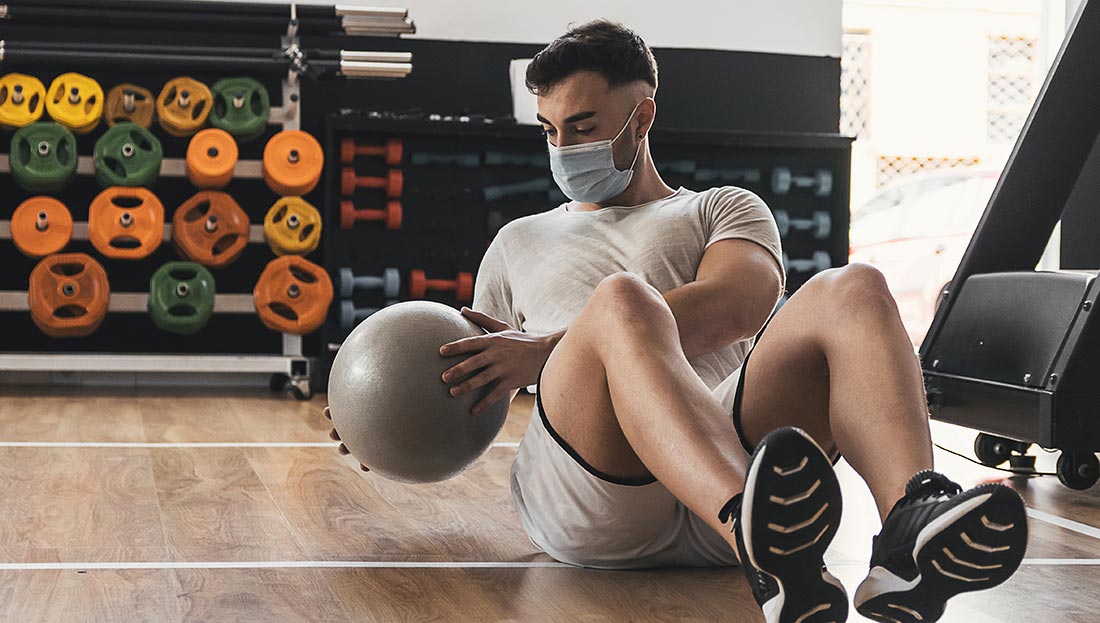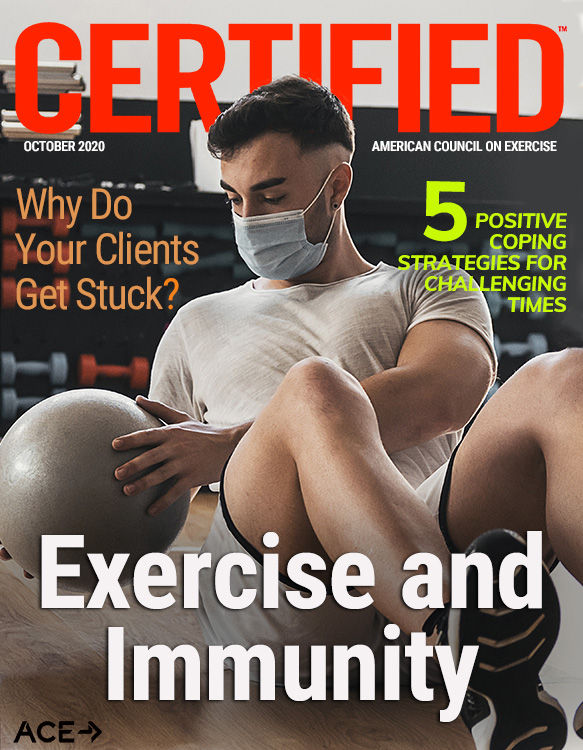
With the onset of the novel coronavirus pandemic at the start of 2020, building a healthy immune system that is able to fight off infection became a top priority for many people. While researchers who study exercise immunology are starting to understand how exercise influences the immune system, there is currently little research investigating exactly how exercise affects the body’s ability to fight COVID-19. However, as researchers Simpson and Katsanis recently wrote in Brain, Behavior and Immunity, “We do know that having elevated levels of cardiorespiratory fitness and exercising at moderate to vigorous intensity can improve immune responses to vaccination, reduce chronic low-grade inflammation and improve various immune markers in several disease states including cancer, HIV, cardiovascular disease, diabetes, cognitive impairment and obesity.” It’s also worth noting that while stress has a negative effect on immunity, exercise has been shown to be particularly effective for reducing stress levels.
Finding the right balance of exercise—the amount that supports the immune system rather than suppresses it—is key. To that end, scientists have identified a “J-curve,” meaning that a certain amount of exercise may provide benefits for supporting the immune system, but too much exercise at too high of an intensity with inadequate recovery time can result in a weakening of the immune system and an increased susceptibility to infection entering the body. As Gleeson notes in the Journal of Applied Physiology, “While engaging in moderate activity may enhance immune function above sedentary levels, excessive amounts of prolonged, high-intensity exercise may impair immune function.”
This article presents a brief review of the immune system and, most importantly, identifies specific steps you can take to help your clients and participants bolster their immune systems and reduce the risk of catching an infectious disease.
The Immune System
The human immune system has two primary subsystems: the innate immune system, which is the first line of defense against developing an infection, and the adaptive immune system, which can produce a specific response to a foreign infection. The innate immune system includes the skin (which prevents infections from entering the body), mucus membranes, acidity of bodily fluids and secretions, and leukocytes (white blood cells), which contain a number of specific cells including T cells, B cells and natural killer (NK) cells. The adaptive immune system produces specific antibodies and elevate leukocytes to fight infections when they are introduced to the body. In general, when a disease or infection is introduced to the body, the initial response is to increase leukocytes in an effort to eliminate the threat. The adaptive immune system can enhance the response; if a specific disease is reintroduced to the body, it already has the antibodies to defeat it.
The function of the first line of defense is to keep foreign pathogens from entering the body in the first place. COVID-19, like a number of diseases, is an airborne infection that can enter through the body’s respiratory system. A 2010 study predicted the possible effects of population-wide mask use on the development of an influenza pandemic using mathematical models and a literature review. These mathematical models were used to determine that the use of certified face masks may limit the spread of influenza and that “mask use not only protects healthy individuals but also reduces the infectiousness of symptomatic and asymptomatic carriers, thus reducing the number and effectiveness of transmission sources with the population…Mask use is virtually the only way to prevent aerosol transmission, which may cause the most severe cases of influenza.” The researchers concluded that “the population-wide use of face masks can be a valuable strategy to delay or contain an influenza pandemic, or at least decrease the infection attack rate.” For this reason, consider wearing a mask, whether when working with a client, teaching a group fitness class or in a public space, as a way to support innate immune system health.
Existing Health Conditions Can Compromise the Immune System
Pre-existing chronic health conditions can overwhelm the immune system, limiting its ability to respond to and fight a secondary infection like COVID-19. In the relatively limited amount of time that doctors have been treating COVID-19, obesity has been identified as a risk factor that could significantly increase the risk of hospitalization and death. In addition, it has been known for some time that levels of body fat can compromise the immune system, leaving the body more susceptible to illness. “Excess body fat, particularly abdominal fat, triggers the production of ‘pro-inflammatory’ immune cells which circulate in the blood and can damage the body,” write Viardot, Lord and Samaras in The Journal of Clinical Endocrinology and Metabolism. “In addition, other immune cells, known as macrophages, are also activated within fat tissues.”
Individuals with obesity and/or other chronic health conditions, such as cardiovascular disease, hypertension, diabetes and cancer, are already overloading the immune system, making it much more likely they will experience severe complications if they contract COVID-19. Preliminary research has identified morbid obesity as a leading indicator of possible morbidity from COVID-19 and found that individuals with obesity [body mass indes (BMI) over 30 kg/m2] were at a significantly higher risk of hospitalization and more likely to be admitted to an intensive care unit. They also were 48% more likely to die from the virus than those who were of normal weight.
For health and exercise professionals, this means that helping clients lose weight is really about helping them move toward optimal health via a strong, vibrant immune system. For individuals living with obesity, increasing physical-activity levels through exercise for the purpose of weight loss could literally become a matter of life and death.
Exercise and the Immune System
It’s important to remember that exercise is a physical stress imposed upon the body, which can have both an acute and chronic effect on the immune system. The sympathetic nervous system (SNS) and hypothalamus-pituitary-adrenal (HPA) axis are activated during exercise to promote energy metabolism. However, they also have an important impact on the immune system’s ability to release the leukocytes responsible for fighting infections. In the acute phase after a single bout of moderate-intensity exercise, levels of leukocytes can increase, which helps to support the immune system.
“The impact of exercise on innate and acquired immune parameters,” write Simpson and colleagues, “is dependent on the intensity of exercise, the duration and overall load of training.” The impact of exercise on the immune system is based on a number of different factors, some of which can be influenced by the programs you design for your clients; other factors are variable based on the individual. Factors that regulate function of the immune system include genetics, age, nutrition, training status, underlying health conditions, psychological stress and medical history.
When it comes to extensive periods of high-intensity exercise or competitions, researchers have identified what they term an “open window” when the immune system is compromised, increasing the likelihood of an infection entering the body. “Various immune cell functions are temporarily impaired following acute bouts of prolonged, continuous heavy exercise,” writes Gleeson, “and athletes engaged in intensive periods of endurance training appear to be more susceptible to minor infections.”
Peake and colleagues concur. “If exercise is repeated again while the immune system is still depressed, this could lead to a greater degree of immunodepression and potentially a longer window of opportunity for infection.” Likewise, Simpson and colleagues found that “arduous bouts of exercise, typically those practiced by athletes and other high-performing personnel (i.e., military), have been associated with suppressed mucosal and cellular immunity, increased symptoms of upper respiratory tract infections, latent viral reactivation and impaired immune responses to vaccine and novel antigens.”
Clearly, exercise intensity has the potential to negatively impact the immune system’s ability to fight off infections. Another variable for how exercise affects the immune system is the availability of glycogen and the metabolism of immune cells. Just like muscle cells, immune cells require fuel to function. Research suggests that exercise, specifically prolonged periods of intense exercise, could limit the amount of energy available for these cells and be a contributing factor to the “open window” phenomenon. Furthermore, carbohydrates ingested during and immediately after exercise may help support optimal immune function. For clients who perform extensive periods of high-intensity physical activity, proper nutrition is particularly important to promote optimal immune system performance.
Another way you can help promote optimal immune function among your clients is by paying attention to respiratory rates. Respiration, the rate of breathing, is what brings oxygen into the lungs—this is where the strength of the mucus lining component of the innate immune system plays an important role. During high-intensity exercise, working muscles use glycogen to produce adenosine triphosphate (ATP), which is the chemical that fuels muscle contractions. A byproduct of glucose metabolism is carbon dioxide (CO2). As the intensity of exercise increases, the rate and force of breathing increases to push CO2 out of the body and pull oxygen in. During exercise, a person’s exposure to airborne pathogens is increased due to their higher rate and depth of breathing. For health and exercise professionals, this presents another argument for limiting the intensity of exercise, especially when teaching classes or working with clients in an indoor environment. It also supports the case for following distancing guidelines established by many municipalities and governments. Keeping an appropriate distance from other exercisers means that whatever they’re expiring (breathing out) during exercise will have a much lower likelihood of affecting others in the immediate area.
When it comes to using exercise to support the immune system, the research literature is overwhelmingly conclusive that a limited amount (45 minutes or less) of moderate-intensity exercise can enhance the immune system and reduce the risk of becoming sick. Workout programs for clients and classes should be adjusted to be shorter in duration and at low-to-moderate intensity to ensure that exercise is helping support the immune system as well as overall health.
Action Steps to Support the Immune System
The good news is that health and exercise professionals can have an important impact on helping clients and class participants support their immune systems to reduce the risk of developing any infectious disease. Based on the available, peer-reviewed evidence, you can play an important role in helping clients to reduce the risk of catching COVID-19, or any other airborne disease, by implementing the following suggestions:
- Wear a mask while teaching and working with clients and make wearing a mask mandatory when individuals exercise in your facility. Yes, it may be awkward and uncomfortable but (1) many local governments have standing orders to wear a mask in an effort to reduce transmission, and (2), consider a mask a part of the body’s defense system against catching a disease in the first place. If a client or class participant refuses to wear a mask or is unable to wear a mask, suggest alternative ways to exercise that maintain social distancing such as virtual or outdoor exercise options.
- You can play an important role in helping your clients and participants increase physical activity and make healthier nutrition choices. When working with clients who have significant overweight or obesity, encourage them to work toward weight-loss goals for the purpose of supporting the immune system. Now more than ever, weight loss is an important component of achieving optimal long-term health.
- Encourage clients to follow a healthy nutrition plan that includes an appropriate amount of carbohydrates. Evidence suggests that restricting carbohydrates could suppress the immune system. According to Peake and colleagues, “A balanced and well-diversified diet that meets the energy demands in exercising individuals is certainly a key component to maintain immune function in response to strenuous exercise.”
- Recommend your clients perform moderate-intensity exercise (i.e., 3 to 4 on the 0-to-10 rating of perceived exertion scale) for fewer than 45 minutes at a time, which is recognized as sufficient for supporting the body’s immune response.
- Reduce the volume and duration of high-intensity exercise. When it comes to high-intensity training, the intensity is more important than the duration. While one four-minute cycle of a Tabata protocol can be enough to improve aerobic efficiency and burn calories, doing more than one may not provide any additional benefits and could actually increase the risk of compromising the immune system. At the end of the day, it simply isn’t worth it.
- When possible, high-intensity exercise should be performed outdoors or in studios with sufficient airflow that are large enough to accommodate recommended distancing guidelines. High-intensity exercise increases the respiration rate, which can spread more germs. Allowing for proper spacing during a workout could reduce the risk of airborne transmission.
- Support the immune system by encouraging healthy sleep habits. Sleep is when the body naturally detoxifies and repairs itself. An extra hour of sleep a night eqates to an additional seven hours a week, which is like sleeping for an entire extra night. By contrast, a lack of sleep can increase activation of the SNS and HPA, which can further suppress the immune system. “Sleep disturbances can depress immunity, increase inflammation and promote adverse health outcomes.”





 by
by 


